AUDI TT ROADSTER 2018 Owners Manual
Manufacturer: AUDI, Model Year: 2018, Model line: TT ROADSTER, Model: AUDI TT ROADSTER 2018Pages: 310, PDF Size: 46.95 MB
Page 261 of 310
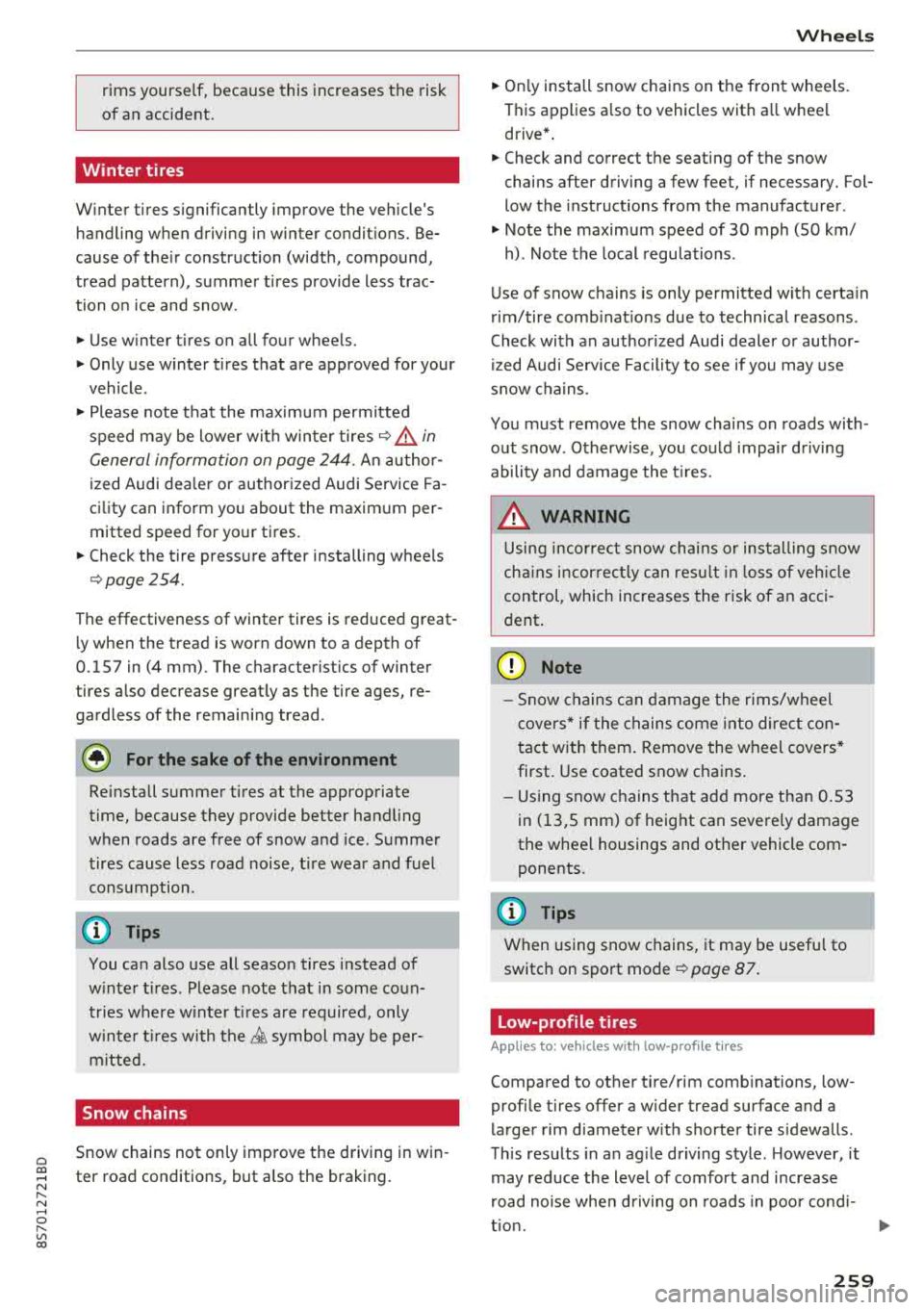
Cl 00 .-< N r--N .-< 0 r--Vl 00
rims yourself, because this increases the risk
of an accident.
Winter tires
Winter tires significantly improve the vehicle 's
handling when driving in winter conditions. Be
cause of their construction (width, compound,
tread pattern), summer tires provide less trac
tion on ice and snow.
.. Use winter tires on all four wheels.
.. Only use winter tires that are approved for your
vehicle .
.. Please note that the maximum permitted
speed may be lower with winter tires
9 .&, in
General information on page 244.
An author
ized Audi dea ler or authorized Audi Service Fa
cility can inform you about the maximum per
mitt ed sp eed for your tires .
.. Check the tire pressure after installing wheels
9page 254.
The effectiveness of winter tires is reduced great
ly when the tread is worn down to a depth of
0 .1S7 in (4 mm) . The chara cteristics of winter
tires also decrease greatly as the tire ages, re
gardless of the remaining tread .
@.l For the sake of the environment
Reinstall summer tires at the appropriate
time, because they provide better handling
when roads are free of snow and ice. Summer
tires cause less road noise, tire wear and fuel
consumption.
(D Tips
You can also use all season tires instead of
w inter tires . Please note that in some coun
tries where w inter tire s are required, only
w int er tires with
the£ symbol may be per
mitted.
Snow chains
Snow chains not only improve the driving in win
ter road conditions, but also the braking.
Wheels
.. Only install snow chains on the front wheels.
This applies a lso to vehicles with all wheel
drive* .
.. Check and correct the seating of the snow
chains after driving a few feet, if necessary. Fol
low the instructions from the manufacturer .
.. Note the maximum speed of 30 mph (SO km/
h) . Note the local regulations .
Use of snow chains is only permitted with certa in
rim/tire comb inat ions due to technical reasons .
Check with an author ized Audi dealer or author
ized Audi Service Facility to see if you may use
snow chains .
You must remove the snow chains on roads with
out snow . Otherwise, you could impair driving
ability and damage the tires .
.8, WARNING
Using incorrect snow chains or install ing snow
chains inc orrectly can resu lt in loss of veh icle
control, which increases the risk of an acci
dent.
(W) Note
- Snow chains can damage the rims/wheel
covers* if the chains come into direct con
tact with them. Remove the wheel covers*
first. Use coated snow chains.
- Using snow chains that add more than O.S3
in (13,S mm) of height can severe ly damage
the whee l housings and other vehicle com
ponents .
(D Tips
When using snow chains, it may be usefu l to
switch on sport mode
~ page 87.
Low-profile tires
App lies to: vehicles wi th low- pro fil e tir es
Compared to other tire/rim combinations, low
profile tires offer a wider tread surface and a
larger rim diameter with shorter tire sidewalls .
This results in an ag ile driving style . However, it
may reduce the level of comfort and increase
r oad noise when driving on roads in poor condi-
tion.
..,_
259
Page 262 of 310
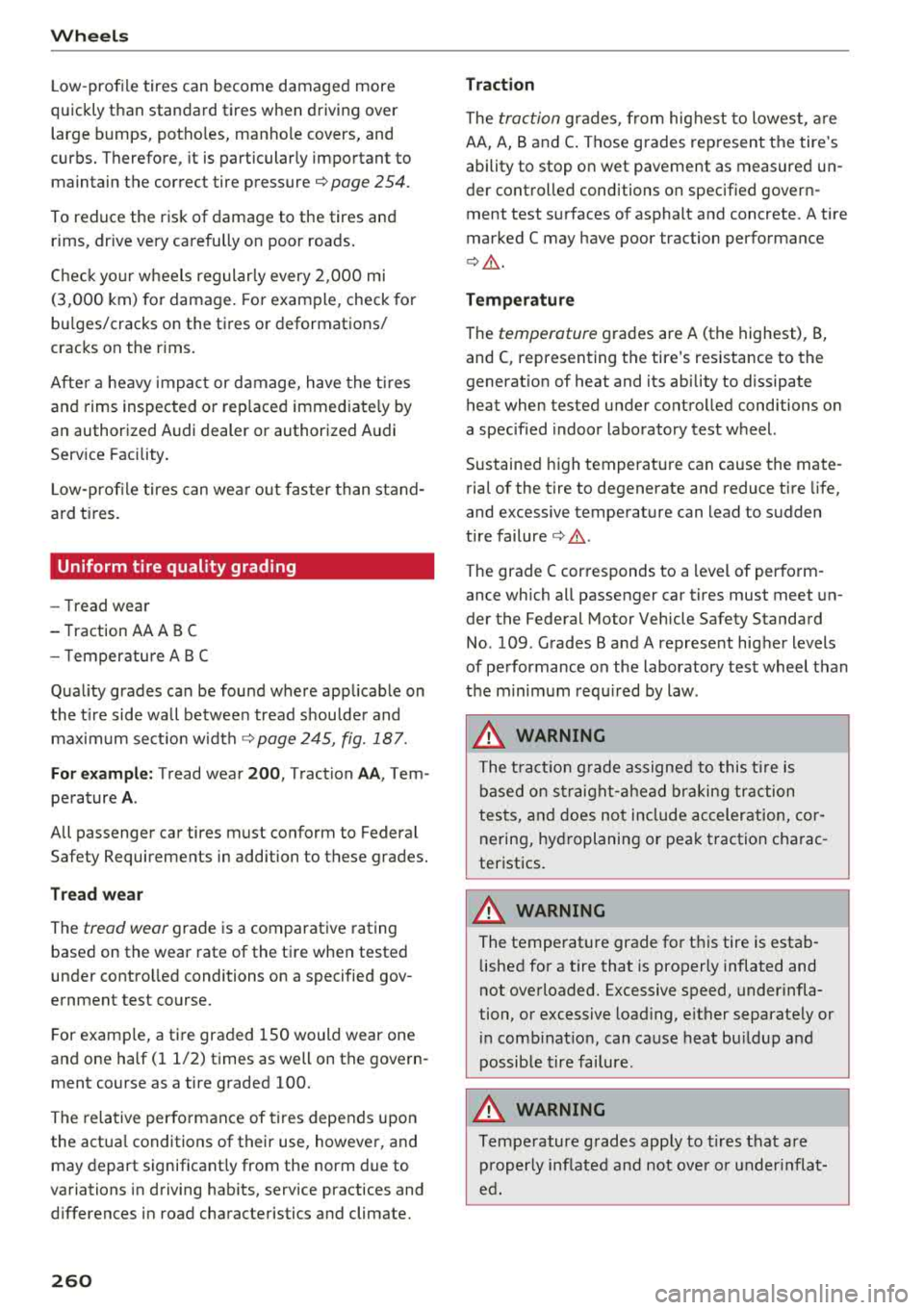
Wheels
Low -profile tires can become damaged more
quickly than standard tires when driving over large bumps, potholes, manhole covers, and
curbs. Therefore, it is particularly important to
maintain the correct tire pressure
c::;, page 254 .
To reduce the risk of damage to the tires and
rims, drive very carefully on poor roads.
Check your wheels regularly every 2,000 mi (3,000 km) for damage. For example, check for
bu lges/cracks on the tires or deformations/
cracks on the rims.
Afte r a heavy impact or damage, have the tires
and rims inspected or replaced immediate ly by
an authorized Audi dealer or authorized Audi
Service Facility.
L ow -profile tires can wear o ut faster than stand
ard tires.
Uniform tire quality grading
- Tread wear
- T raction
AA A B C
- T emperature ABC
Qual ity grades can be found where appl icable on
the tire side wall between tread shoulder and
maximum sect ion w idth
c::;, page 245, fig. 187.
For example: Tread wear 200, Traction AA, Tem
perature
A .
All passenger car tires must conform to Federal
Safety Requirements in addition to these grades.
Tread wear
The tread wear grade is a comparative rating
based on the wear rate of the tire when tested
under contro lled conditions on a specified gov
ernment test course.
F or examp le, a tire graded
150 would wear one
and one half
(1 1/2) times as well on the govern
ment course as a tire graded
100.
The relative performance of tires depends upon
the actual conditions of their use, however, and may depart significant ly from the norm due to
variations in driving habits, service practices and differences in road characteristics and climate.
260
Traction
The traction grades , from highest to lowest , are
AA,
A, Band C. Those grades represent the tire's
ability to stop on wet pavement as measured un
der controlled conditions on specified govern
ment test surfaces of asphalt and concrete. A tire
marked C may have poor traction performance
c::;, .&. .
Temperature
The temperature grades are A (the highest), B,
and C, representing the tire's resistance to the
generat ion of heat and its ability to dissipate
heat when tested under controlled conditions on
a specified indoor laboratory test wheel.
Sustained high temperature can cause the mate rial of the tire to degenerate and reduce tire life,
and excessive temperature can lead to sudden
tire failure
c::;, ,&. .
The grade C corresponds to a level of perform
ance which all passenger car tires must meet un
der the Federal Motor Vehicle Safety Standard
No .
109 . Grades Band A represent higher levels
of performance on the laboratory test wheel than
the m inimum required by law.
A WARNING -
The traction grad e assigned to this tire is
based on straight-ahead braking traction
tests, and does not include acceleration, cor
nering, hydroplaning or peak traction charac
teristics.
A WARNING
The temperature grade for this tire is estab
lished for a tire that is properly inflated and
not overloaded. Excessive speed, underinfla
tion, or excessive loading, either separately or
in comb inat ion, can cause heat bu ildup and
possible tire failure.
A WARNING
-
-
Temperature grades apply to tires that are
properly inflated a nd not over o r underinflat
ed.
Page 263 of 310
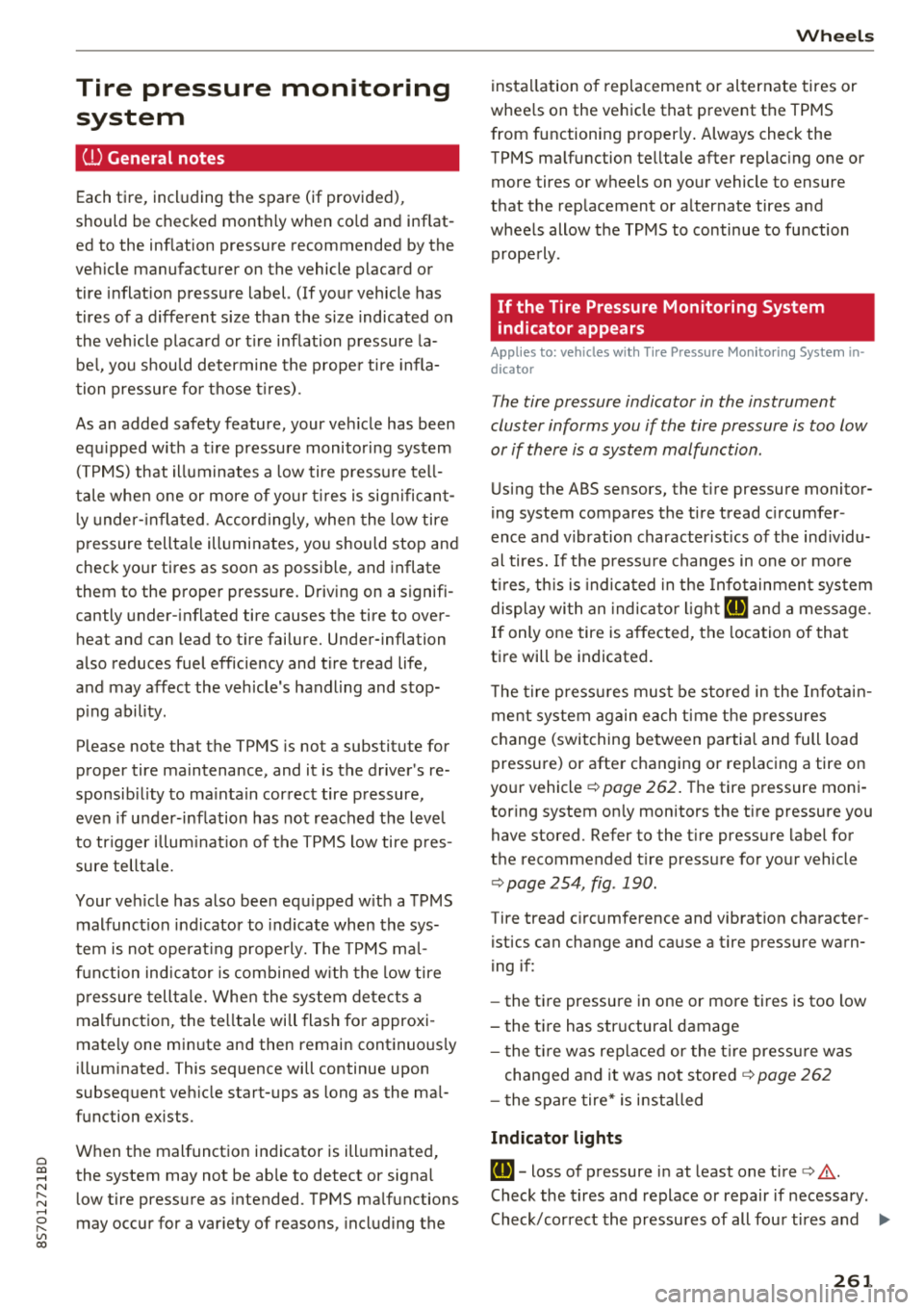
Cl 00 .-< N r-N .-< 0 r-Vl 00
Tire pressure monitoring system
(J_) General notes
Each tire, incl uding the spare (if provided),
should be checked month ly when co ld and inflat
ed to the inf lation pressure recommended by the
ve hicle manufacturer on the vehicle placard or
tire inflat ion pressure label. (If your vehicle has
tires of a d ifferent s ize tha n the s ize indicated on
the veh icle placa rd or t ire inflation pressure la
be l, you s hou ld determine the prope r tir e infla
tion pressure fo r th ose tires).
As an added safety feature, your ve hicle has been
equ ipped w ith a t ire pressu re monito ring system
(TPMS) that ill uminates a low tire p ress ure tell
tale whe n one or more of yo ur t ires is sign ificant
l y unde r-infla ted. Accord ingly, whe n the low tire
p ressure tellta le illuminates, yo u should stop and
check your tires as soon as possible, and inflate
them to the proper press ure. D riving on a signifi
cantly under-inflated tire causes the tire to ove r
h eat and can lead to t ire failure. Under-inflation
a lso reduces fuel efficiency and ti re tread life,
and may affect the veh icle's handling and stop
p ing ability .
P lease note that the TPMS is not a substitute for
proper tire maintenance, and it is the driver's re
sponsib il ity to ma inta in correct tire pressure,
even if u nder-inflation has not reached t he leve l
to tr igger illum inat io n of t he TPM S low tire p res
sure telltale.
Your veh icle has also been equ ipped w ith a TPMS
malfunct ion ind icator to indicate when the sys
tem is not operat ing properly. The TPMS ma l
f u nction ind icator is combined w ith the low tire
p ressure tellta le. Whe n the system det ects a
mal function, the te lltale wi ll flash fo r approxi
mate ly one mi nute and then remain continuous ly
illum inated. This sequence will continue upon
subseq uent ve hicle start-ups as long as the ma l
function ex ists .
W hen t he malfunctio n indicator is ill uminated,
the system may not be ab le to detect or signa l
low t ire press ure as intended. TPMS ma lfunctions
may occur for a var iety of reasons, including the
Wheels
insta llation o f replacement or alternate tires or
whee ls on the vehicle that prevent the TPMS
from functioning p roperly . Always check the
TPMS ma lfunction te lltale after replac ing one or
more tires or wheels on you r vehicle to ensure
t h at the rep lacement or a lternate tires a nd
wheels allow t he TPMS to continue to function
prope rly.
If the Tire Pressure Monitoring System
indicator appears
Applies to: vehicles with Tire Pressure Monitoring System in
dicator
The tire pressure indicator in the instrument
cluster informs you if the tire pressure is too low
or if there is a system malfunction.
U sing the ABS se nsors, the t ire pressure monitor
ing system compares the tire tread c ircumfer
ence and v ibration characterist ics of the ind ividu
al tires. If the pressu re changes in one o r more
t ir es, th is is indica ted in the Info tainment sys tem
display wi th an indica to r li ght
ti] and a message.
If only one ti re is affected, the location of tha t
tire will be indicated.
T he tire press ures mus t be store d in the Infota in
me nt system agai n ea ch t ime t he p ressures
change (switching between partia l and full load
pressure) or after c hanging or replacing a tire on
yo ur vehicle
¢ page 262 . The tire pressure moni
toring system on ly monitors the tire pressure you
have stored. Refer to the t ire pressure label for
the recommended t ire pressure for your vehicle
¢ page 254, fig . 190 .
Tire tread c ircumference and vibration character
istics can change and cause a tire pressu re warn
i ng if:
- the ti re pressure in one or more tires is too low
- the tire has str uctural damage
- t he t ire w as replaced or the t ire pressu re w as
changed and it was no t stored ¢
page 262
- the spare tire* is i nstalled
Indicator lights
ti] -loss of pressure in at least one tire ¢,& .
Check the t ires and replace or repair if necessary.
Check/correct the pressures of all fou r tires and
.,.
261
Page 264 of 310
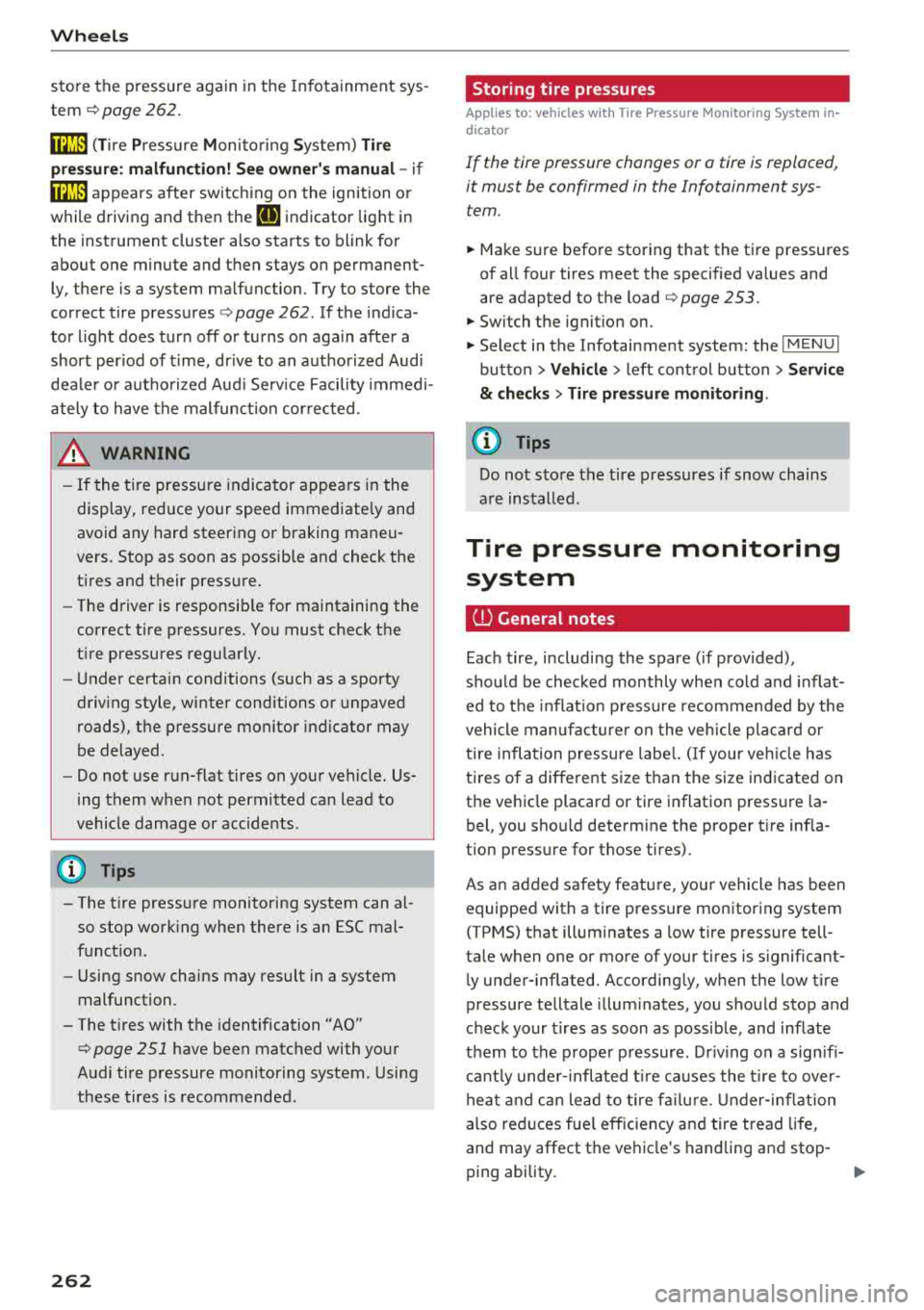
Wheels
store the pressure again in the Infotainment sys
tem
i::> page 262 .
mm (Tir e Pr essure Monitoring System) Tire
pressure: malfunction! See owner's manual -
if
mm appears after switching on the ignition or
while driving and then the
[DJ indicator light in
the instrument cluster also starts to blink for
about one minute and then stays on permanen t
ly, there is a system malfunction. Try to store the
correct tire pressures
<=:> page 262 . If the indica
tor light does turn off or turns on again after a
short period of time, drive to an authorized Audi
dealer or authorized Aud i Serv ice Facility immedi
ately to have the malfunction corrected .
_& WARNING
-If the tire pressure indicator appears in the
display, reduce your speed immediately and
avoid any hard steering or braking maneu
vers. Stop as soon as possible and check the
tires and their pressure.
- The driver is responsible for maintaining the
correct tire pressures. You must check the
tire pressures regularly.
-Under certain conditions (such as a sporty
driving style, winter conditions or unpaved
roads), the pressure monitor indicator may
be delayed .
- Do not use run-flat tires on your vehicle. Us
ing them when not permitted can lead to
vehicle damage or accidents .
(D Tips
- The tire pressure monitoring system can al
so stop working when there is an ESC mal
function.
- Using snow chains may result in a system
malfunction.
- The tires with the identification
"AO"
¢page 251 have been matched with your
Audi tire pressure monitoring system . Using
these tires is recommended.
262
Storing tire pressures
Applies to: vehicles with Tire P ressure Monitoring System in
dicator
If the t ire pr essure chang es or a tire is replaced ,
it must be confirmed in the Infotainment sys
tem.
.,. Make sure before storing that the tire pressures
of all four tires meet the specified values and
a re adapted to the load
<=:>page 253.
.,. Switch the ignition on.
.,. Select in the Infotainment system : the!M ENUI
button > Vehicle > left control button > Service
& checks> Tire pressure monitoring .
(D Tips
Do not store the tire pressures if snow chains
are installed .
Tire pressure monitoring
system
ill General notes
Each tire, including the spare (if provided),
should be checked monthly when cold and inflat
ed to the inflation pressure recommended by the
vehicle manufacturer on the vehicle placard or
tire inflation pressure label. (If your vehicle has
tires of a different size than the size indicated on
the vehicle placard or tir e inflation pr essure la
bel, you should determine the proper tire infla
tion pressure for those tires).
As an added safety feature, your vehicle has been
equipped with a tire pressure monitoring system
( T PMS) that illuminates a low tire pressure tell
tale when one or more of you r tires is significant
ly under-inflated. Accordingly, when the low tire
pressure telltale illuminates, you should stop and
check your tires as soon as possible, and inflate
them to the proper pressure . Driving on a signifi
cant ly under-inflated t ire causes the tire to over
heat and can lead to tire failur e. Under-inflation
also reduces fuel efficiency and tire tread life,
and may affect the vehicle's handling and stop-
ping ability.
..,.
Page 265 of 310
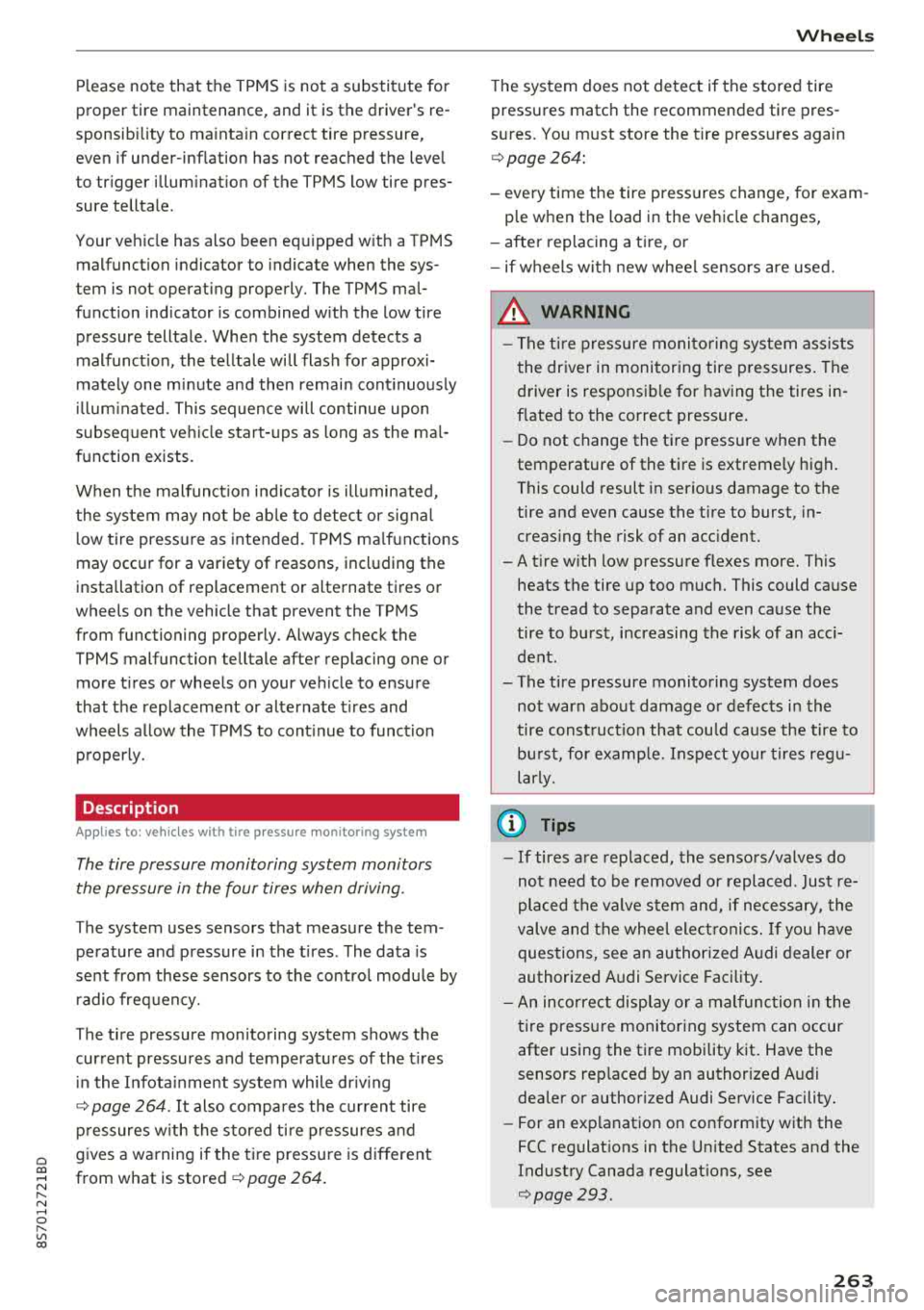
Cl 00 .-< N r-N .-< 0 r-Vl 00
Please note that the TPMS is not a substitute for
proper tire maintenance, and it is the driver's re
sponsibility to maintain correct tire pressure,
even if under-inflation has not reached the level
to trigger illumination of the TPMS low tire pres
sure telltale .
Your vehicle has also been equipped with a TPMS malfunction indicator to indicate when the sys
tem is not operating properly. The TPMS mal
function indicator is combined with the low tire pressure telltale. When the system detects a
malfunction, the telltale will flash for approxi
mately one minute and then remain continuously
illuminated. This sequence will continue upon
subsequent vehicle start-ups as long as the mal
function exists.
When the malfunction indicator is illuminated,
the system may not be able to detect or signal
low tire pressure as intended. TPMS malfunctions
may occur for a variety of reasons, including the
installation of replacement or alternate tires or
wheels on the vehicle that prevent the TPMS
from functioning properly . Always check the
TPMS malfunction telltale after replacing one or
more tires or wheels on your vehicle to ensure
that the replacement or alternate tires and
wheels allow the TPMS to continue to function
properly.
Description
Applies to: vehicles with tire pressure monitor ing system
The tire pressure monitoring system monitors
the pressure in the four tires when driving.
T he system uses sensors that measure the tem
perature and pressure in the tires . The data is
sent from these sensors to the control module by radio frequency.
T he tire pressure monitoring system shows the
current pressures and temperatures of the tires
in the Infotainment system while driving
¢ page 264. It also compares the current tire
pressures with the stored tire pressures and
gives a warning if the tire pressure is different
from what is stored
¢ page 264 .
Wheels
The system does not detect if the stored tire
pressures match the recommended tire pres
sures. You must store the tire pressures again
¢ page 264:
- every time the tire pressures change, for exam
ple when the load in the vehicle changes,
- after replacing a tire, or
- if wheels with new wheel sensors are used.
_& WARNING
- The tire pressure monitoring system assists
the driver in monitoring tire pressures. The
driver is responsible for having the tires in
flated to the correct pressure.
- Do not change the tire pressure when the
temperature of the tire is extremely high.
This could result in serious damage to the
tire and even cause the tire to burst, in
creasing the risk of an accident.
- A tire with low pressure flexes more. This heats the tire up too much. This could cause
the tread to separate and even cause the
tire to burst, increasing the risk of an acci
dent.
- The tire pressure monitoring system does not warn about damage or defects in the
tire construction that could cause the tire to
burst, for example. Inspect your tires regu
larly.
(D Tips
- If tires are replaced, the sensors/valves do
not need to be removed or replaced . Just re
placed the valve stem and, if necessary, the
valve and the wheel electronics. If you have questions, see an authorized Audi dealer or
authorized Audi Service Facility.
- An incorrect display or a malfunction in the
tire pressure monitoring system can occur
after using the tire mobility kit. Have the
sensors replaced by an authorized Audi
dealer or authori zed Audi Service Facility.
- For an explanation on conformity with the
FCC regulations in the United States and the
Industry Canada regulations, see
¢ page 293.
263
Page 266 of 310
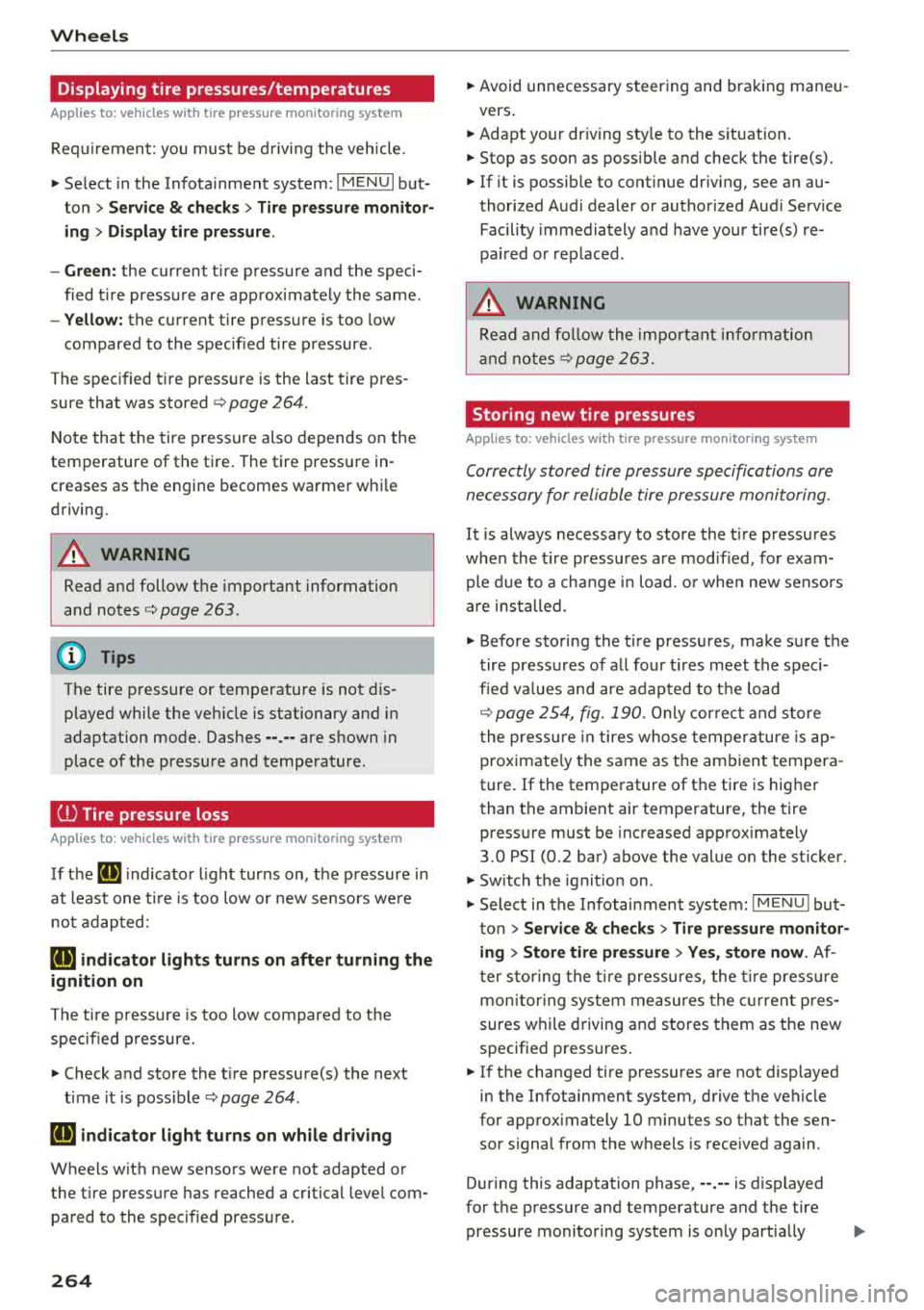
Wheels
Displaying tire pressures/temperatures
Applies to: vehicles with tire pressure monitoring system
Requirement: you must be d rivi ng the veh icle .
"'Se lect in the Infotainment system: IMENU I but
ton
> Service & checks > Tire pre ssur e monitor
ing > Di splay tire pressure.
- Green:
the current tire pressure and the speci
fied t ire pressure are approximately the same .
-Yellow: the current tire pressure is too low
compared to the specified tire pressure .
The specified tire press ure is the last tire pres
sure that was stored
c> page 264.
Note that t he tire p ressure also de pends on the
temperature of the tire . The tire press ure in
creases as the engine becomes wa rmer whi le
driving.
A WARNING
Read and follow the important information
and notes
c> page 263.
(D Tips
The tire pressure or temperature is not d is
played while the veh icle is stationary and in
adaptation mode. Dashes --.--are shown in
place of the pressu re and temperature.
(D Tire pressure loss
Applies to: vehicles with tire pressure monitoring system
-
If the Rt] indicato r light turns on, the p ressure in
at least one t ire is too low o r new sensors we re
not adapted :
[I] indicator lights turns on after turning the
ignition on
The tire pressure is too low compared to the
specified p ressure.
"' Check and store the t ire pressure(s) the next
time it is poss ible
c> page 264 .
[I] indicator light turns on while dri ving
Wheels with new sensors were not adapted or
the t ire pressure has reached a critical leve l com
pared to the specified pressure .
264
"'Avoid unnecessary steering and brak ing maneu -
vers .
"'Adapt your dr iving sty le to the s ituation.
"' Stop as soon as possible and check the tire(s).
"'If it is possib le to continue driv ing, see an au-
thorized Audi dealer or authorized Aud i Service
Facility immediately and have your tire(s) re
pa ired o r rep laced .
A WARNING
Read and fo llow the impo rtant info rmation
and n otes
c>page 263.
Storing new tire pressures
Applies to: vehicles with tire pressure monitoring system
Correctly stored tire pressure specifications are
necessary for reliable tire pressure monitoring.
-
It is always necessary to store the t ire pressures
whe n the t ire pressu res a re modified, fo r exam
ple d ue to a change in load . o r when new senso rs
a re installed.
"' Before storing the t ire pressures, make su re the
tire pressures of all four t ires meet the spec i
fied va lues and are adapted to t he load
c::> page 254, fig. 190 . Only correct and store
the pressure in tires whose temperature is ap
proximate ly the same as the ambient tempera
t u re . If the temperature of the tire is higher
than the ambient air temperature, the tire pressure must be increased approximately
3.0 PSI (0.2 bar) above the value on the st icker.
"' Switch the ignit ion on .
"'Select in the Infotainment system : IMENU! but
ton
> Service & checks > Tire pressure monitor
ing > Store tire pre ssure > Ye s, store now .
Af
ter storing the t ire pressures, the t ire press ure
mon itor ing system measures the c urrent pres
sures while driving and stores them as the new
specified pressures .
"'If the changed tire pressures are not displayed
in the Infotainment system, drive the vehicle
for approximately 10 minutes so that the sen sor signa l from the wheels is received again .
During this adaptation phase, -- .- - is d isplayed
for the pressure and temperature and the tire pressure monitoring system is on ly partially
Page 267 of 310
![AUDI TT ROADSTER 2018 Owners Manual Cl 00 .-< N r-N .-< 0 r-Vl 00
availab le . It only provides a warning if one o r
more tire pressures is be low the minimum per
mitted specif ied pressure .
If the
[I] indica to r l AUDI TT ROADSTER 2018 Owners Manual Cl 00 .-< N r-N .-< 0 r-Vl 00
availab le . It only provides a warning if one o r
more tire pressures is be low the minimum per
mitted specif ied pressure .
If the
[I] indica to r l](/img/6/57668/w960_57668-266.png)
Cl 00 .-< N r-N .-< 0 r-Vl 00
availab le . It only provides a warning if one o r
more tire pressures is be low the minimum per
mitted specif ied pressure .
If the
[I] indica to r lig ht turns on and the mes
sage
Tire pressure: wheel change detected .
Please check all tires and store pressures in
MMI also appears, the system has detected that
the posit ion of the sensors has changed because
of a tire rotation, or that new sensors were in
stalled . Store the new tire pressures.
A WARNING -
Read and follow the important informa tion
and notes<=;>
page 263.
Malfunctions
App lies to: ve hicles with tire press ure m onitoring system
If t he tire pressure monitoring system is not
available, the
m;i ind icat or light appears in the
in str ument cluster display along with th e mes
sage
Tire pressure: malfunction! See owner's
manual.
I f the @m in dica tor light appears after switch
ing the ignition on or while dr iv in g and the
[I] in
d icator light also blinks for approximate ly one
minute and t hen stays on, there is system ma l
function. The following are examples of sit ua
tions that cou ld cause a malfunction:
-If the message appears at the end o f the adap
tation phase, the system may not detect one or
severa l of the wheel senso rs necessa ry for pres
s ur e monitoring. This may result from one or
more wheels being installed without wheel sen
sors or with incompatible wheel sensors .
- A wheel sensor o r another component has
failed.
- Using snow cha ins can affect the f unction of
the system because of the shie lding effect of
the cha ins.
- The tire pressure monitor ing system is not
available due to a malfunction.
- Transmitters with the same frequency, such as
headphones or remote-controlled dev ices, may
cause a temporary system malfunction due to
the strong electromagnetic field .
Wheels
The m;i indicator lig ht and the message turn off
once the tire pressure monitoring system is avail
able again. If you cannot co rrect the malfunction
and
the m indicator light stays on, drive imme
diately to an authorized Audi dea ler or author
ized Audi Se rvice Facility to have the malfunct ion
repaired.
265
Page 268 of 310
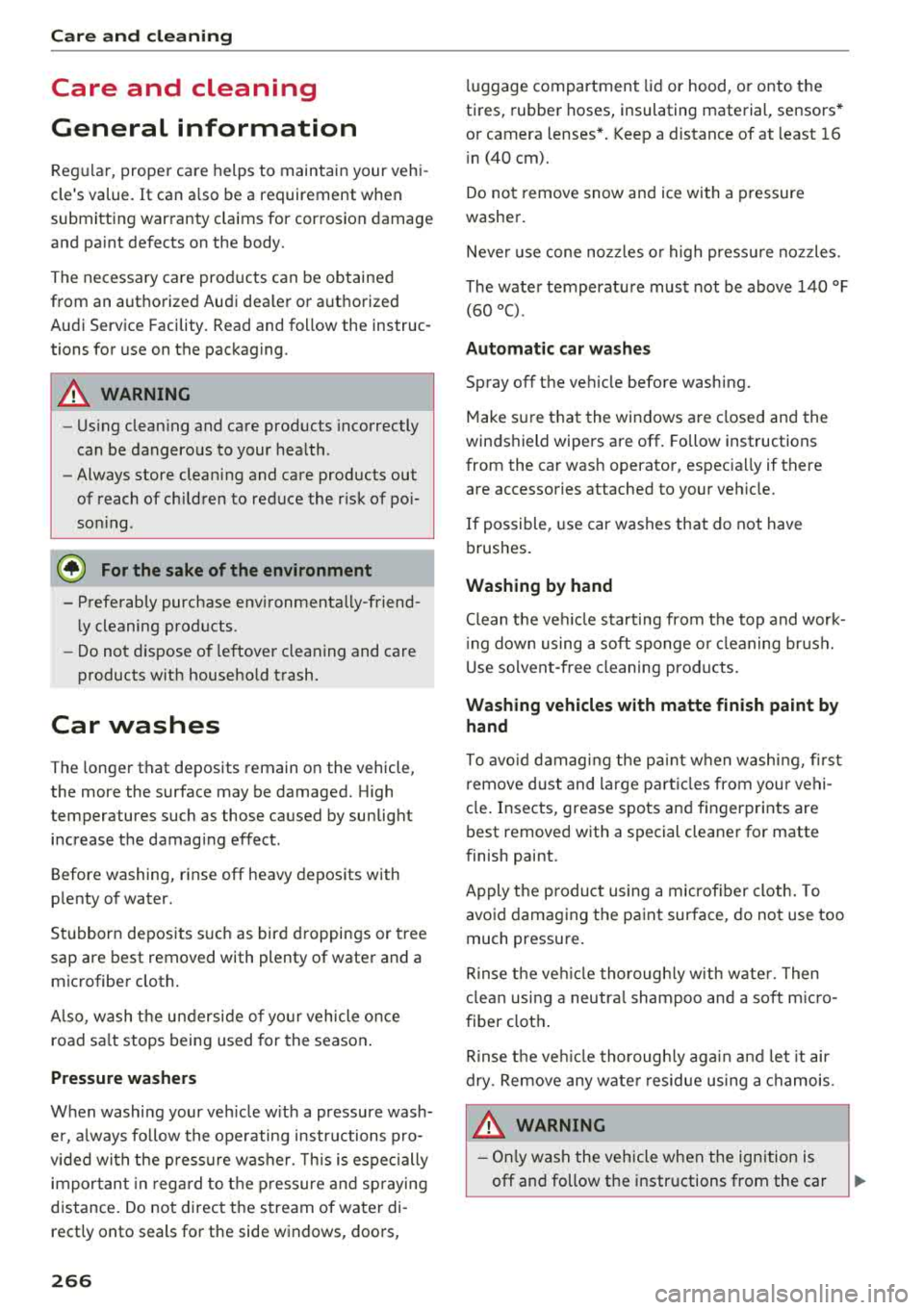
Care and cleaning
Care and cleaning
General information
Regular, proper care helps to maintain your vehi
cle's value. It can also be a requirement when
submitting warranty claims for corrosion damage
and paint defects on the body.
The necessary care products can be obtained
from an authorized Audi dea ler or authorized
Audi Service Facility. Read and follow the instruc
tions for use on the packaging.
A WARNING
-Using cleaning and care products incorrectly
can be dangerous to your health.
- Always store clean ing and care products out
of reach of children to reduce the r isk of poi
sonin g.
@ For the sake of the environment
- Preferab ly purchase environmenta lly-friend
l y cleaning products.
- Do not dispose of leftover cleaning and care
products with household trash.
Car washes
The longer that deposits remain on the vehicle,
the more the surface may be damaged. High
temperatures such as those caused by sunlight increase the damaging effect .
Before washing, rinse
off heavy deposits with
p lenty of water.
Stubborn deposits such as bird droppings or tree
sap are best removed with plenty of water and a
microfiber cloth.
A lso, wash the underside of yo ur vehicle once
road sa lt stops being used for the season.
Pressure washers
When washing your veh icle w ith a pressure wash
er, always follow the operating instructions pro
vided with the press ure washer. This is espec ially
impor tant in r egard to the pressure and spraying
distance. Do not direct th e stream of water di
rect ly onto seals for the side windows, doors,
266
lug gage compartment lid or hood, or onto the
tires, rubber hoses, insulating material, sensors*
or camera lenses* . Keep a distance of at least 16
i n
(40 cm).
Do not remove snow and ice with a pressure
washer.
Never use cone nozz les or high pressure nozzles.
The water temperature must not be above
140 °F
(60 °() .
Automatic car washes
Spray off the vehicle before washing.
Make sure that the windows are closed and the
winds hield wipers are
off. Follow instructions
from the car wash operator, espec ia lly if there
are accessories attached to your veh icle.
If possible, use car washes that do not have
brushes.
Washing by hand
Clean the vehicl e starting from the top and work
in g down using a soft sponge or cl eaning br ush.
Use solvent-free cleaning products.
Washing vehicles with matte finish paint by
hand
To avoid damaging the paint when washing, first
remove dust and large part icles from you r vehi
cle. Insects, grease spots and fingerprints are
best removed with a special cleaner for matte
finish paint.
Apply t he product using a microfiber cloth. To
avoid damaging th e paint surface, do not use too
much pressure.
R inse the vehicl e thoroughly with wate r. Then
clean using a neutra l shampoo and a soft micro
f iber cloth .
Rinse the vehicl e thoroughly again and let it air
dry. Remove any water residue using a chamois.
A WARNING
-Only wash the vehicle when the ignition is
off and follow the instructions from the car
-
Page 269 of 310
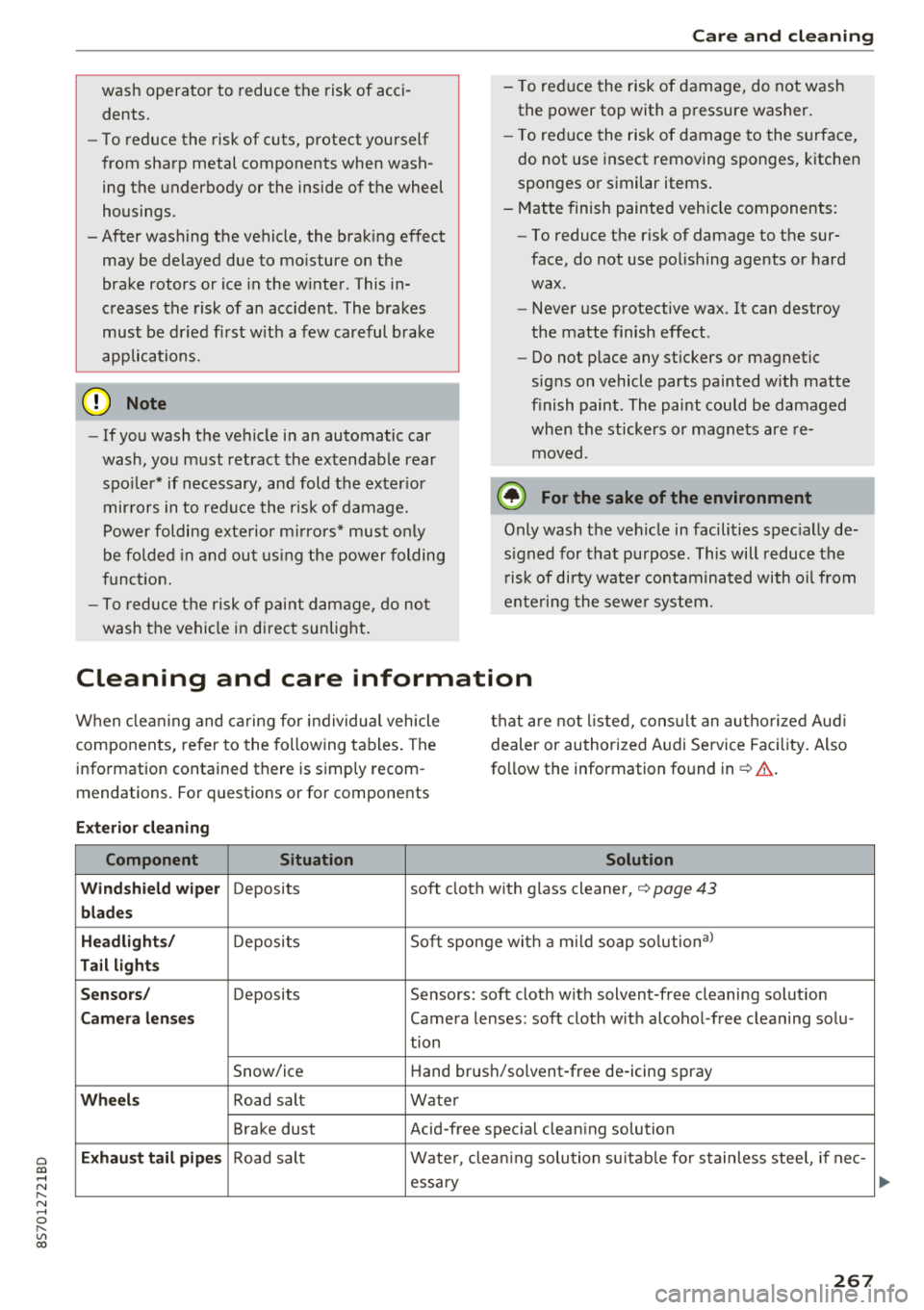
Cl 00 .-< N r--N .-< 0 r--Vl 00
wash operator to reduce the risk of acci
dents.
- To reduce the risk of cuts, protect yourself
from sharp metal components when wash ing the underbody or the inside of the wheel
hous ings.
- After wash ing the vehicle, the brak ing effect
may be delayed due to mo isture on the
brake rotors or ice in the w inter . This in
c reases the risk of an acc ident. The brakes
must be d ried fi rst w it h a few careful b rake
applications.
@ Note
- If you wash the vehicle in an automatic car
wash, you m ust retract the extendable rear
spo ile r* if necessary, and fold the exter ior
mir rors in to red uce the r isk of damage.
Power folding exte rior m irrors* must o nly
be fo lde d in a nd out u sing the power folding
f unct ion .
- To reduce the risk of p ain t d amage, do no t
wash the vehi cle i n di rect sunlig ht.
Care and cleaning
- T o red uce the risk of damage, do not was h
the power top with a pressure washer.
- T o red uce the risk of damage to the s urface,
do not use insect removing sponges, kitchen
sponges or similar items .
- Mat te finish painted veh icle components:
- To reduce the risk of damage to t he sur-
face, do not use po lish ing agents or hard
wax.
- Never use protective wax. It can destroy
the matte finish effect .
- Do not place any stickers or magnetic
signs on vehicle parts painted with matte
finish paint. The paint cou ld be damaged
when the stickers or magnets are re
moved.
@ For the sake of the environment
Only wash the vehicle in facilities spec ially de
s igned for that pu rpose . This will reduce the
r isk of di rty wate r contam inated with o il from
ente ring the sewe r sys tem.
Cleaning and care information
When cleani ng and ca ring for individua l vehicle
components, refer to the following tables . The
information contained there is simp ly recom
mendations. For questions or for components t
h at are not l isted, cons ult an autho rized Aud i
dealer or authorized A udi Se rvice Fac ility . Also
fo llow the information fo und
in ¢& .
Ext erior cleaning
Component Situation Solution
Windshield wiper
Deposits soft cloth with glass cleaner, ¢ page 43
blades
Headli ghts/
Deposits Soft sponge with a m
ild soap so lutiona )
Tail light s
Se nsors /
Deposits Sensors: soft cloth with solvent-free cleaning solut ion
Cam era len ses Camera lenses: soft cloth w ith alcohol -free cleaning solu -
tion
Snow/ice Hand brush/solvent-free de-icing spray
Wheels Road salt Water
Brake dust Acid-free special clean ing solution
Exhaust tai l pipes Road salt Water, clea ning solution su itab le for stainless stee l, if nee-
essa ry
267
Page 270 of 310
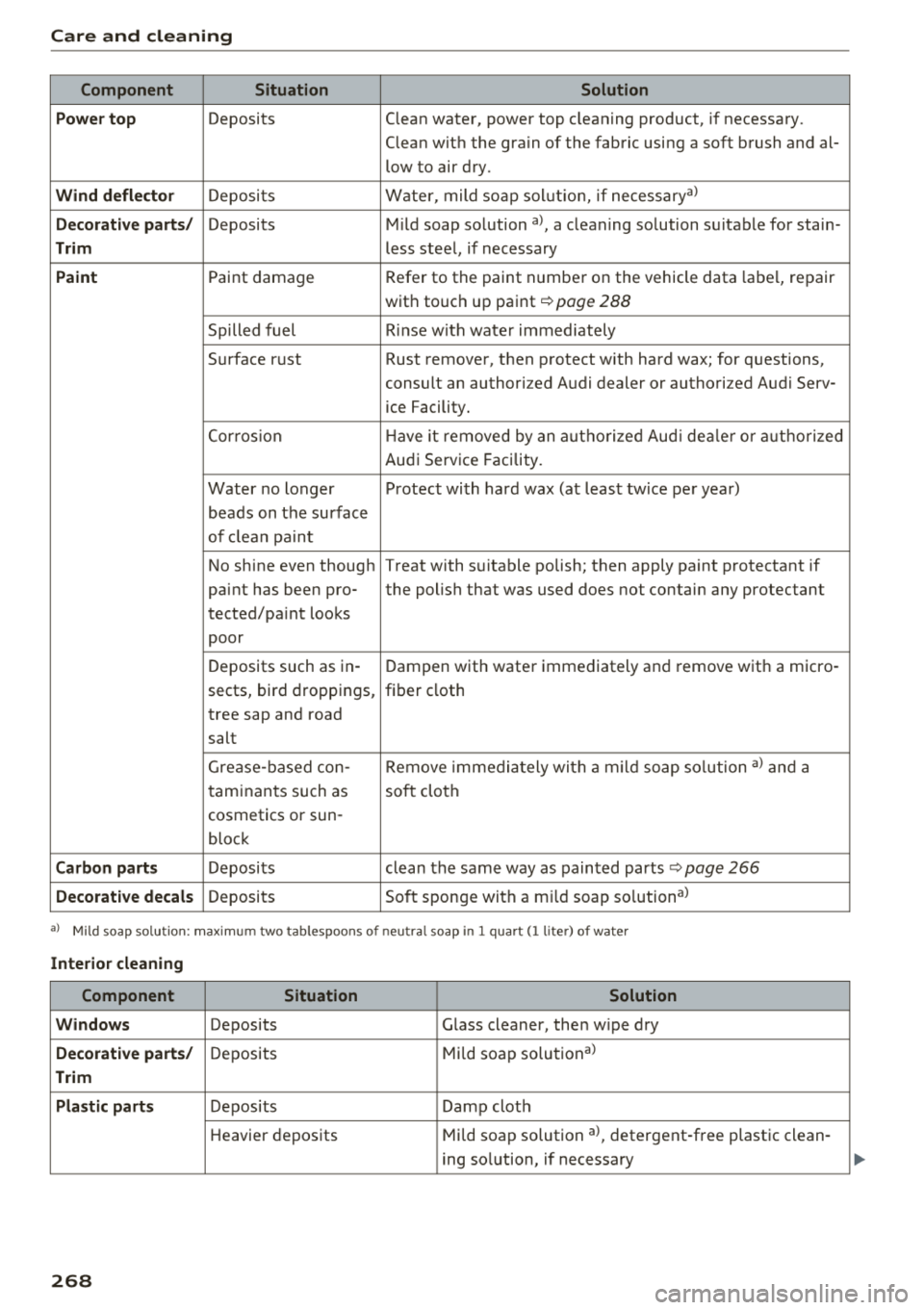
Care and cleaning Component Situation Solution
Power top
Deposits Clean water, power top cleaning product, if necessary.
Clean with the grain of the fabric using a soft brush and al- low to air dry.
Wind deflector Deposits Water, mild
soap solution, if necessaryal
Decorative parts/ Deposits Mild soap solution al, a cleaning solution suitable for stain-
Trim less steel, if necessary
Paint Paint damage Refer
to the paint number on the vehicle data label, repair
with touch up paint¢
page 288
Spilled fuel Rinse with water immediately
Surface rust Rust remover, then protect with hard wax; for questions,
consult
ani authorized Audi dealer or authorized Audi Serv-
ice Facility.
Corrosion Have it removed by an authorized Audi dealer or authorized
Audi Service Facility.
Water no longer Protect with hard wax (at least twice per year)
beads on the surface
of clean paint
No shine even though Treat with suitable polish; then apply paint protectant if
paint has been pro- the polish that was used does not contain any protectant
tected/pa int looks
poor
Deposits such as in- Dampen with water immediately and remove with a micro-
sects, bird droppings,
fiber cloth
tree sap and road
salt
Grease-based con- Remove immedia tely with a mild soap solution
a) and a
taminants such as soft cloth
cosmetics or sun-
block
Carbon parts Deposits clean the same way as painted parts ¢page 266
Decorative decals Deposits Soft sponge with a mild soap so lutional
al M ild soap so lution: maxim um two tablespoons of neutra l soap in 1 quart (1 lite r) of water
Interior cleaning
Component Situation Solution
Windows
Deposits Glass cleaner, then wipe dry
Decorative parts/ Deposits Mild soap solutional
Trim
Plastic parts
Deposits Damp cloth
Heavier deposits Mild soap solution
al, detergent-free plastic clean-
ing so lution, if necessary
268